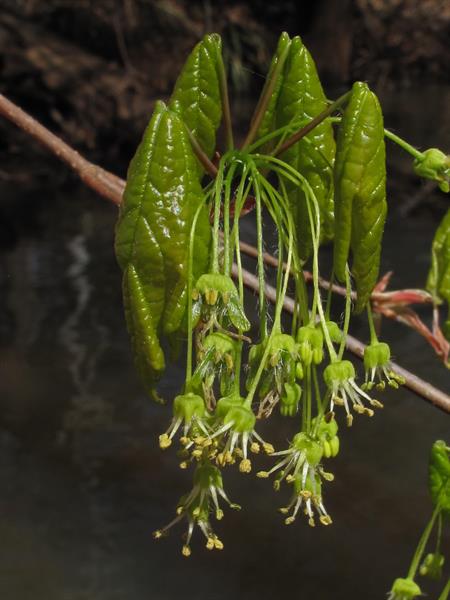
Origin/Endemic status: Endemic
Taxonomy Comments: Ward (2004b) discusses the reasons for accepting A. floridanum as the correct name for this species; the Michauxian name A. barbatum is associated with specimens that are demonstrably A. saccharum.
Synonymy: = K3, K4, S13, Va, Ward (2004b); = Acer barbatum Michx. – C, Il, K1, Tx, misapplied; = Acer saccharum Marshall ssp. floridanum (Chapm.) Desmarais – Fl4, Mo2, RAB, Tn, WH3, Desmarais (1952), Murray (1970); = Acer saccharum Marshall var. floridanum (Chapm.) Small & A.Heller – Ar; = Saccharodendron barbatum (Michx.) Nieuwl., misapplied; = Saccharodendron floridanum (Chapm.) Nieuwl. – S; > Acer barbatum Michx. var. barbatum – F, G, misapplied; > Acer barbatum Michx. var. longii (Fernald) Fernald – F, G, misapplied
Heliophily: 4
Hover over a shape, letter, icon, or arrow on the map for definition or see the legend.
 © Bruce A. Sorrie | Original Image ⭷
© Bruce A. Sorrie | Original Image ⭷ © Richard & Teresa Ware CC-BY-NC, permission granted to NCBG
© Richard & Teresa Ware CC-BY-NC, permission granted to NCBG © Gary P. Fleming
© Gary P. Fleming © Gary P. Fleming
© Gary P. Fleming © Gary P. Fleming
© Gary P. Fleming © Scott Ward | Original Image ⭷
© Scott Ward | Original Image ⭷ © Erik Danielson source | Original Image ⭷
© Erik Danielson source | Original Image ⭷ © Scott Ward, some rights reserved (CC BY), uploaded by Scott Ward source CC-BY | Original Image ⭷
© Scott Ward, some rights reserved (CC BY), uploaded by Scott Ward source CC-BY | Original Image ⭷ © Richard & Teresa Ware CC-BY-NC, permission granted to NCBG
© Richard & Teresa Ware CC-BY-NC, permission granted to NCBG © Richard & Teresa Ware CC-BY-NC, permission granted to NCBG
© Richard & Teresa Ware CC-BY-NC, permission granted to NCBG © Alan M. Cressler | Original Image ⭷
© Alan M. Cressler | Original Image ⭷ © Erik Danielson source | Original Image ⭷
© Erik Danielson source | Original Image ⭷ © Scott Ward | Original Image ⭷
© Scott Ward | Original Image ⭷ © Richard & Teresa Ware CC-BY-NC, permission granted to NCBG
© Richard & Teresa Ware CC-BY-NC, permission granted to NCBG © J.W. Hardin | Original Image ⭷
© J.W. Hardin | Original Image ⭷Feedback
See something wrong or missing on about Acer floridanum? Let us know here: (Please include your name and email if at all complicated so we can clarify if needed.)
Cite as...